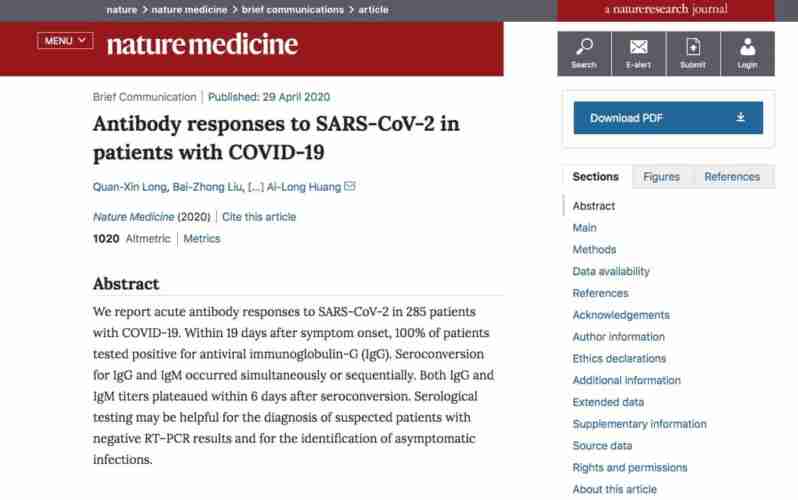Chi guarisce dal Covid-19 svilupperebbe gli anticorpi protettivi al virus. La conferma arriva proprio da uno studio della Chongqing Medical University, di Quan-Xin Long, Bai-Zhong Liu, Ai-Long Huang e molti altri ricercatori pubblicato sulla rivista Nature Medicine il 29 aprile 2020. Lo studio avrebbe rilevato nel 100% dei pazienti analizzati (285) la presenza degli anticorpi IgG, cioè quelli prodotti durante la prima infezione e che per gran parte proteggono a lungo termine. Ciò significa, peraltro, che il test sierologico può essere utile per diagnosticare i pazienti sospetti, risultati negativi al tampone, e identificare quelli asintomatici e che si sta andando probabilmente in una direzione corretta.
In dettaglio:
Abstract
Segnaliamo risposte anticorpali acute a SARS-CoV-2 in 285 pazienti con COVID-19. Entro 19 giorni dall’esordio dei sintomi, il 100% dei pazienti è risultato positivo all’immunoglobulina G (IgG) antivirale. La sieroconversione per IgG e IgM si è verificata contemporaneamente o in sequenza. Entrambi i titoli di IgG e IgM hanno raggiunto il plateau entro 6 giorni dalla sieroconversione. I test sierologici possono essere utili per la diagnosi di pazienti sospetti con risultati RT-PCR negativi e per l’identificazione di infezioni asintomatiche.
Corpo della ricerca in lingua originale:
The continued spread of coronavirus disease 2019 (COVID-19) has prompted widespread concern around the world, and the World Health Organization (WHO), on 11 March 2020, declared COVID-19 a pandemic. Studies on severe acute respiratory syndrome (SARS) and Middle East respiratory syndrome (MERS) showed that virus-specific antibodies were detectable in 80–100% of patients at 2 weeks after symptom onset1,2,3,4,5,6. Currently, the antibody responses against SARS-CoV-2 remain poorly understood and the clinical utility of serological testing is unclear7.
A total of 285 patients with COVID-19 were enrolled in this study from three designated hospitals; of these patients, 70 had sequential samples available. The characteristics of these patients are summarized in Supplementary Tables 1 and 2. We validated and used a magnetic chemiluminescence enzyme immunoassay (MCLIA) for virus-specific antibody detection (Extended Data Fig. 1a–d and Supplementary Table 3). Serum samples from patients with COVID-19 showed no cross-binding to the S1 subunit of the SARS-CoV spike antigen. However, we did observe some cross-reactivity of serum samples from patients with COVID-19 to nucleocapsid antigens of SARS-CoV (Extended Data Fig. 1e). The proportion of patients with positive virus-specific IgG reached 100% approximately 17–19 days after symptom onset, while the proportion of patients with positive virus-specific IgM reached a peak of 94.1% approximately 20–22 days after symptom onset (Fig. 1a and Methods). During the first 3 weeks after symptom onset, there were increases in virus-specific IgG and IgM antibody titers (Fig. 1b). However, IgM showed a slight decrease in the >3-week group compared to the ≤3-week group (Fig. 1b). IgG and IgM titers in the severe group were higher than those in the non-severe group, although a significant difference was only observed in IgG titer in the 2-week post-symptom onset group (Fig. 1c, P = 0.001).
Link alla ricerca




